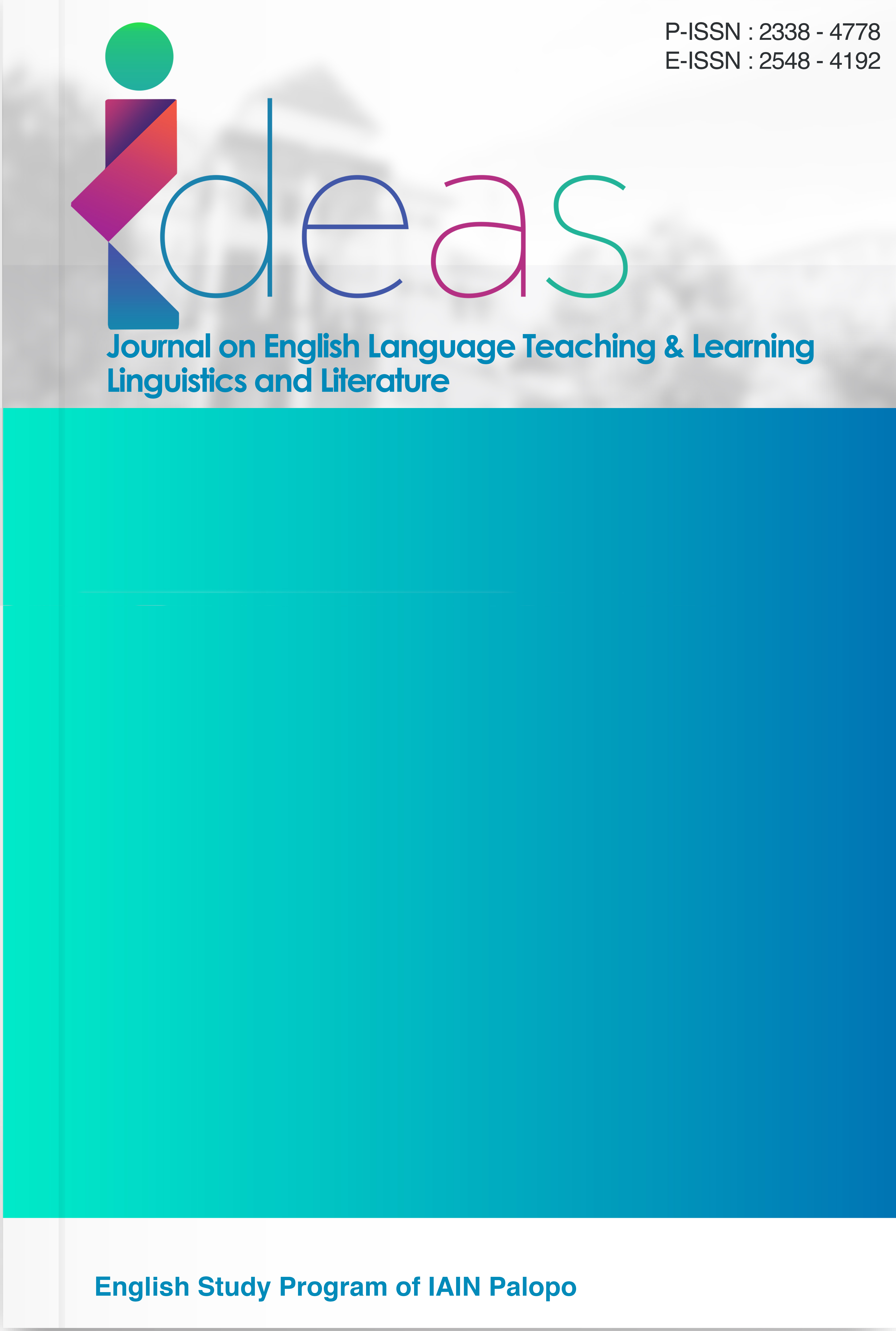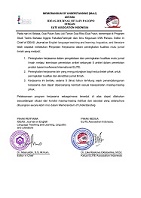Identifying Hate Speech on Israeli Netizent Tiktok
DOI:
https://doi.org/10.24256/ideas.v13i2.5081Keywords:
Hate Speech, sttrategi simpoliteness, Identifying Hate Speech On Israeli Netizent Tiktok, PragmaticsAbstract
The purpose of this study is to find out the impoliteness strategy of hate speech netizens use on TikTok accounts against the state of Israel and to find out the dominant types of impoliteness strategies of hate speech netizens use on TikTok accounts against the state of Israel. This study used the descriptive-qualitative method. In the results of the data analysis, the writer found four types of impoliteness strategies in comments on Israeli state accounts, namely Bald on on-record impoliteness. There are 14 (12%) comments of positive impoliteness, 8 (8%) comments of negative impoliteness, 59 (59%) comments of sarcasm, politeness, 19 (19%) comments of withhold politeness, and 0 (0%) comments. The writer finds that the most dominant type of strategy used is the impoliteness strategy or negative impoliteness. This type is more frequently used because of the high emotional dissatisfaction shown by the speaker against Israel. Sensitive topics such as political conflicts or controversial international situations often provoke strong emotions and discontent among social media users. Netizens believe that Israel violates human rights or treats certain groups unfairly, especially in the context of the Israeli-Palestinian conflict. This can cause a negative reaction, and some social media users may use negative disobedience to show support or solidarity to groups or parties involved in conflict with
References
Apriliyani, V., Hamzah, H., & Wahyuni, D. (2019). Impoliteness Strategies Used By Male and Female Haters of Habib Rizieq and Felix Siauw Found in Instagram Comments. English Language and Literature, 8(1). https://doi.org/10.24036/ell.v8i1.103213
Astuti, F. (2019). Perilaku Hate Speech Pada Remaja Di Media. Jurnal Psikologi, Hate Speech, 1–13.
Bani, M., & Masruddin, M. (2021). Development of Android-based harmonic oscillation pocket book for senior high school students. JOTSE: Journal of Technology and Science Education, 11(1), 93-103.
Bajari, A., Koswara, I., & Erlandia, D. R. (2021). Hatenography: An Analysis of Hate Speech on Facebook in 2019 Indonesian Presidential Campaign. Jurnal Komunikasi: Malaysian Journal of Communication, 37(4), 122–141. https://doi.org/10.17576/JKMJC-2021-3704-08
Brown, A. (2015). Hate Speech Law. In Hate Speech Law. https://doi.org/10.4324/9781315714899
Claudia, V. S., & Wijayanto, Y. R. (2020). Tindak Tutur Ujaran Kebencian (Hate Speech) Pada Komentar Forum Diskusi COVID-19 dalam Jejaring Sosial Facebook “Ini Kebumen.” Prosiding Seminar Nasional Linguistik Dan Sastra (SEMANTIKS), 533–542.
Culpeper, J. (1996). Towards an Anatomy of Impoliteness Towards an anatomy of impoliteness. 2166(March 1996). https://doi.org/10.1016/0378-2166(95)00014-3
Dwi Floranti, A. (2022). Racism Toward Chinese Ethnic Group in Indonesian Social Media: Hate Speeches Analysis from Forensic Linguistic Perspective. Jomantara: Indonesian Journal of Art and Culture, 2(Vol. 2 No. 2 July 2022), 112–130. https://doi.org/10.23969/jijac.v2i2.5753
Ferdiansa, D., Darwis, M., & Said, I. M. (2022). Types of Hate Speech in Jokowi’s Instagram Comment Column during the PPKM Period: Forensic Linguistic Analysis. Jurnal Indonesia Sosial Teknologi, 3(05), 621–631. https://doi.org/10.36418/jist.v3i5.467
Husnaini, H. (2022). Development of Self Esteem-Oriented Micro Teaching Materials for IAIN Palopo English Education Students. IDEAS: Journal on English Language Teaching and Learning, Linguistics and Literature, 10(1), 538-560.
Merlyn Titahena, & Prihadi. (2023). Analysis of Hate Speech in Instagram Social Media Celebrity Indonesia Chandrika Sari Jusman. Britain International of Linguistics Arts and Education (BIoLAE) Journal, 5(2), 185–190. https://doi.org/10.33258/biolae.v5i2.913
Nasution, M. M., Izar, J., & Afifah, I. H. (2021). An Analysis of Hate Speech Against K-Pop Idols and Their Fans on Instagram and Twitter from The Perspective of Pragmatics. JETLi: Journal of English Teaching and Linguistics, 2(2), 91–99. https://doi.org/10.55616/jetli.v2i2.143
Ningsi, F., & Syahraini, A. (2022). An Analysis of Hate Speech on Students Interaction and The Impact on Student Motivation. JIIP - Jurnal Ilmiah Ilmu Pendidikan, 5(12), 5810–5813. https://doi.org/10.54371/jiip.v5i12.1306
Nurhadiyanto, L., Octaviani, M. Y., & Octaviani, M. Y. (2021). Analysis of Neutralization Theory in Hatespeech Cases Againts Kekeyi, Young Lex and Nissa Sabyan on Instagram. Iccd, 3(1), 202–207. https://doi.org/10.33068/iccd.vol3.iss1.338
Paramita, T. P., Subyantoro, S., & Pristiwati, R. (2022). The Patterns of Hate Speech in The Viewers ’ Comments Column on The Channel Youtube with The Topic of Puan Maharani In 2019. 11(3), 265–274. https://doi.org/https://journal.unnes.ac.id/sju/index.php/seloka
Pasaribu, A. N. (2021). Hate Speech on Joko Widodo’S Offical Facebook: an Analysis of Impoliteness Strategies Used By Different Gender. ELTIN JOURNAL, Journal of English Language Teaching in Indonesia, 9(1), 56–64.
Permatasari, D. I., & Subyantoro2, S. (2020). Ujaran Kebencian Facebook Tahun 2017-2019. Jurnal Sastra Indonesia, 9(1), 62–70. https://doi.org/10.15294/jsi.v9i1.33020
Riska Novita Ria, & Teguh Setiawan. (2023). Forensic Linguistic Analysis of Netizens’ Hate Speech Acts in Tik-Tok Comment Section. Britain International of Linguistics Arts and Education (BIoLAE) Journal, 5(2), 141–152. https://doi.org/10.33258/biolae.v5i2.894
Roviana, D. (2018). Impoliteness Strategies in American Tv Series “Bones” Season 2 Episode 1-3. Impoliteness Strategies In… (Dea Roviana S), 346.
Sarifuddin, S., Tadjuddin, M., & Iswary, E. (2021). A Hate and Provocative Speech Act in Social Media: A Forensic Linguistics Study. ELS Journal on Interdisciplinary Studies in Humanities, 4(3), 363–368. https://doi.org/10.34050/elsjish.v4i3.18196
Setiawandari, H., & Munandar, A. I. (2021). Hate Speech In Election 2019: Case Study Of Youth Organizations. Journal of Strategic and Global Studies, 4(1). https://doi.org/10.7454/jsgs.v4i1.1037
Subyantoro, Suseno, Zuliyanti, & Fitri, S. F. . (2023). Impoliteness Strategy for Cyberbullying in Indonesian on Instagram Social Media. Kembara, 9(2), 735–749. http://ejournal.umm.ac.id/index.php/kembara
Tanjung, A. F., Wardana, M. K., & Mayasari, M. (2023). Hate Speech Addressed to Puan Maharani on Social Media: Pragmatic Approach. Kajian Linguistik Dan Sastra, 2(3), 245–255. https://doi.org/10.22437/kalistra.v2i3.27810
Wulandari S. (2022). Hate Speech on Rocky Gerung Official Youtube Channel Against President Joko Widodo: a Pragmatic Study. International Journal of Social Science, 2(2), 1311–1320. https://doi.org/10.53625/ijss.v2i2.3058
Yuliyanti, T., Subyantoro, S., & Pristiwati, R. (2020). Form of Hate Speech Comments on Najwa Shihab Youtube Channels in The General Election Campaign of President and Vice President of The Republic of Indonesia 2019. Seloka: Jurnal Pendidikan Bahasa Dan Sastra Indonesia, 9(3), 254–263. https://doi.org/10.15294/seloka.v9i3.42513
Downloads
Published
Issue
Section
Citation Check
License
Copyright (c) 2025 Wulan Sari Silalahi, Arsen Nahum Pasaribu, Rotua Elfrida

This work is licensed under a Creative Commons Attribution-ShareAlike 4.0 International License.
Authors retain copyright and grant the journal right of first publication with the work simultaneously licensed under an Attribution-ShareAlike 4.0 International (CC BY-SA 4.0) that allows others to share the work with an acknowledgement of the work's authorship and initial publication in this journal.
Authors are able to enter into separate, additional contractual arrangements for the non-exclusive distribution of the journal's published version of the work (e.g., post it to an institutional repository or publish it in a book), with an acknowledgement of its initial publication in this journal.
Authors are permitted and encouraged to post their work online (e.g., in institutional repositories or on their website) prior to and during the submission process, as it can lead to productive exchanges, as well as earlier and greater citation of published work (See the Effect of Open Access)




